第二章语法2
- 格式:doc
- 大小:203.00 KB
- 文档页数:29
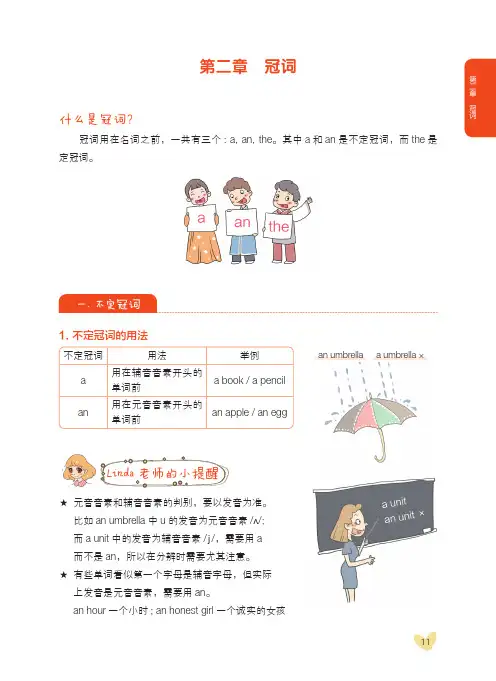
第二章 冠词什么是冠词?冠词用在名词之前,一共有三个: a, an, the 。
其中a 和an 是不定冠词,而the 是定冠词。
1. 不定冠词的用法不定冠词用法举例a 用在辅音音素开头的单词前a book / a pencilan用在元音音素开头的单词前an apple / an eggLinda 老师的小提醒★ 元音音素和辅音音素的判别,要以发音为准。
比如an umbrella 中u 的发音为元音音素/ʌ/;而a unit 中的发音为辅音音素/ j /,需要用a 而不是an ,所以在分辨时需要尤其注意。
★ 有些单词看似第一个字母是辅音字母,但实际上发音是元音音素,需要用an 。
an hour 一个小时; an honest girl 一个诚实的女孩an umbrellaa umbrella ×2. 不定冠词在不同句子中表达不同含义1) 表示事物的数量为1I have an apple and a banana.我有一个苹果和一个香蕉。
There is a pencil in the pencil-box.铅笔盒里有一支铅笔。
2) 表示一类事物A rabbit can jump. 兔子会跳。
I want to see a doctor. 我想去看医生。
3) 表示“每一”I go to the cinema twice a year. 我每年去电影院两次。
How much are the apples? Two yuan a kilo. 苹果多少钱?每公斤两元。
3. 不定冠词的一些固定用法a rest 休息一下have a look 看一看havea while 一会儿have a fever 发烧fora walk 散步haveLinda老师的小提醒在不定冠词a/an的固定用法中,其实a / an没有十分明确的含义,只是习惯用法,但也不可遗漏。
定冠词the在名词之前有特指的作用。
即“这个,那个,这些,那些”等,用法较多。

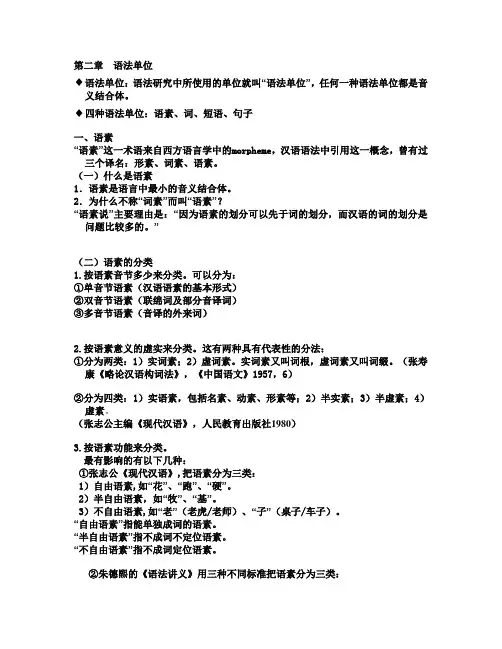
第二章语法单位♦语法单位:语法研究中所使用的单位就叫“语法单位”,任何一种语法单位都是音义结合体。
♦四种语法单位:语素、词、短语、句子一、语素“语素”这一术语来自西方语言学中的morpheme,汉语语法中引用这一概念,曾有过三个译名:形素、词素、语素。
(一)什么是语素1.语素是语言中最小的音义结合体。
2.为什么不称“词素”而叫“语素”?“语素说”主要理由是:“因为语素的划分可以先于词的划分,而汉语的词的划分是问题比较多的。
”(二)语素的分类1.按语素音节多少来分类。
可以分为:①单音节语素(汉语语素的基本形式)②双音节语素(联绵词及部分音译词)③多音节语素(音译的外来词)2.按语素意义的虚实来分类。
这有两种具有代表性的分法:①分为两类:1)实词素;2)虚词素。
实词素又叫词根,虚词素又叫词缀。
(张寿康《略论汉语构词法》,《中国语文》1957,6)②分为四类:1)实语素,包括名素、动素、形素等;2)半实素;3)半虚素;4)虚素。
(张志公主编《现代汉语》,人民教育出版社1980)3.按语素功能来分类。
最有影响的有以下几种:①张志公《现代汉语》,把语素分为三类:1)自由语素,如“花”、“跑”、“硬”。
2)半自由语素,如“牧”、“基”。
3)不自由语素,如“老”(老虎/老师)、“子”(桌子/车子)。
“自由语素”指能单独成词的语素。
“半自由语素”指不成词不定位语素。
“不自由语素”指不成词定位语素。
②朱德熙的《语法讲义》用三种不同标准把语素分为三类:1)以能否单独成句为标准,能单独成句的叫自由语素,不能单独成句的叫粘着语素;2)以能否单独成词为标准,能单独成词的为成词语素,不能单独成词的为不成词语素;3)以语素在组合时位置是否固定为标准,组合时位置固定的语素叫定位语素,位置不固定的语素叫不定位语素。
按每一个标准分为两类,相互交叉,最后得出的结果是四类:A.成词不定位自由语素。
“人、吃、好”B.成词定位粘着语素。
“和、而、了、吗”C.不成词不定位粘着语素。
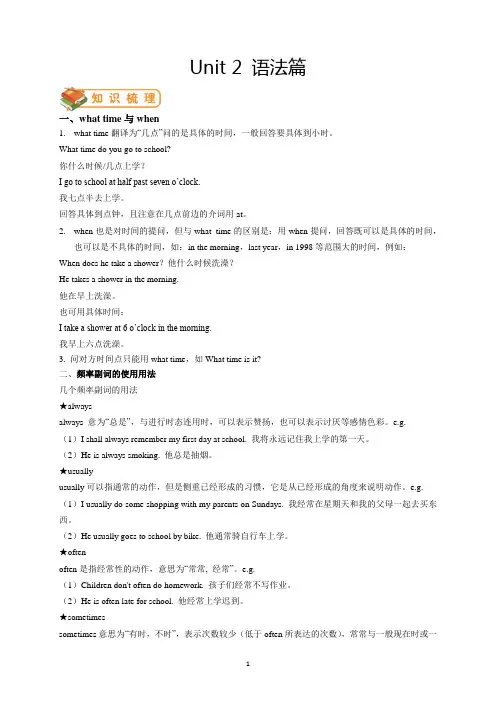
Unit 2 语法篇一、what time与when1.what time翻译为“几点”问的是具体的时间,一般回答要具体到小时。
What time do you go to school?你什么时候/几点上学?I go to school at half past seven o’clock.我七点半去上学。
回答具体到点钟,且注意在几点前边的介词用at。
2.when也是对时间的提问,但与what time的区别是:用when提问,回答既可以是具体的时间,也可以是不具体的时间,如:in the morning,last year,in 1998等范围大的时间,例如:When does he take a shower?他什么时候洗澡?He takes a shower in the morning.他在早上洗澡。
也可用具体时间:I take a shower at 6 o’clock in the morning.我早上六点洗澡。
3. 问对方时间点只能用what time,如What time is it?二、频率副词的使用用法几个频率副词的用法★alwaysalways 意为“总是”,与进行时态连用时,可以表示赞扬,也可以表示讨厌等感情色彩。
e.g.(1)I shall always remember my first day at school. 我将永远记住我上学的第一天。
(2)He is always smoking. 他总是抽烟。
★usuallyusually可以指通常的动作,但是侧重已经形成的习惯,它是从已经形成的角度来说明动作。
e.g. (1)I usually do some shopping with my parents on Sundays. 我经常在星期天和我的父母一起去买东西。
(2)He usually goes to school by bike. 他通常骑自行车上学。
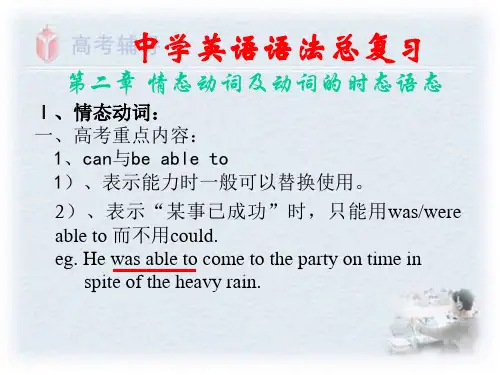
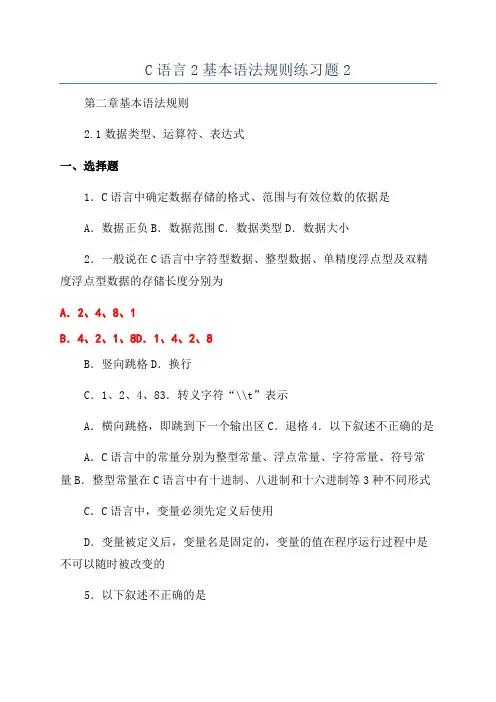
C语言2基本语法规则练习题2第二章基本语法规则2.1数据类型、运算符、表达式一、选择题1.C语言中确定数据存储的格式、范围与有效位数的依据是A.数据正负B.数据范围C.数据类型D.数据大小2.一般说在C语言中字符型数据、整型数据、单精度浮点型及双精度浮点型数据的存储长度分别为A.2、4、8、1B.4、2、1、8D.1、4、2、8B.竖向跳格D.换行C.1、2、4、83.转义字符“\\t”表示A.横向跳格,即跳到下一个输出区C.退格4.以下叙述不正确的是A.C语言中的常量分别为整型常量、浮点常量、字符常量、符号常量B.整型常量在C语言中有十进制、八进制和十六进制等3种不同形式C.C语言中,变量必须先定义后使用D.变量被定义后,变量名是固定的,变量的值在程序运行过程中是不可以随时被改变的5.以下叙述不正确的是A.C语言中的字符常量是用一对单引号('')括起来的单个字符B.字符串常量是用一对双引号(““)括起来的字符序列C.字符型数据与整型数据之间不可以通用。
D.为了便于判断字符串是否结束,系统会自动在最后一个字符后面加上一个转义字符(\\0)6.在赋值语句中用来将运算表达式的值赋给变量的“=”称为A.等号B.赋值运算符C.关系运算符D.逻辑运算符7.设a=12,n=3,则执行表达式a%=n+3后a的值为A.3B.0C.6D.12D.3D.4D.1198.设,A=0,B=1表达式!A&&B的值是A.1B.0C.29.在16位PC机环境下,字符串“A”应占的字节数为A.2B.1C.010.采用十进制数为表示方法,则077是A.77B.112C.6311.设某为float型变量,y为double型变量,a为int型变量,b 为long型变量,c为char型变量,则表达式某+y某a/某+b/y+c计算结果的类型为A.intB.longC.doubleD.char12.设a,c为int型变量,进行a=(c=5,c+5,c/2)运算后的结果为A.2B.5C.2.5D.013.在C语言中,表示逻辑“真”和“假”的值分别是A.0、1B.1、2C.1、014.C语言中表示a小于b或小于c的表达式为A.ac&&b>cB.a>c||b>cC.a>b||b>cD.a>b&&b>c16.a和b中有一个小于c的表达式为A.aB.aD.0和3D.1和1D.2D.35D.2、117.若有a=2,b=3,c=4,则表达式a==3和a=3的值分别为A.0和0B.1和3C.3和318.表达式!(1<3)||(2>5)和!(4<=8)&&(7>=3)的值分别为A.1和0B.0和0C.0和1某19.设a=4,计算表达式a=1,a+5,a++的值为A.1B.5C.1020.设某=4,y=8,计算表达式y=(某++)某(--y)的值为A.28B.32C.4021.设有语句chara=`\\72`;则变量包含的字符数为A.3B.2个C.1D.422.设有说明语句:chara='\\123abc';则变量a包含的字符数为A.4B.6C.5D.723.下列叙述正确的是A.赋值语句中的“=”是表示左边变量等于右边表达式B.赋值语句中左边的变量值不一定等于右边表达式的值C.赋值语句是由赋值表达式加上分号构成的D.某+=y;不是赋值语句24.下列选项中,可以作为C语言标识符的是A.3tuB.#tuC.tu3D.tu.3D.tudent3D.13.8eD.chard;25.下列选项中,不可以作为C语言标识符的是A.numB.turbo_cC.print26.下列选项中,不可以作为C语言常量的是A.”abc”B.1/2C.M27.下列选项中,正确的一组语句是A.chara;B.charb;C.charc;a=M;b=55;c=”M”;d=”55”;28.已知字母b的ASCII码值为98,如ch为字符型变量,则表达式ch=b+5-2的值为A.eB.dC.102D.10029.下列不是字符串常量的是A.“1818\B.“aad”C._abdcD.“a”30.在C语言中,int、char和hort三种类型数据所占用的内存是A.均为2个字节B.由用户定义C.是任意的D.由所用机器的机器字长决定31.设int类型的数据长度为2个字节,则unignedint类型数据的取值范围是A.0至255C.-32768至3276732.以下是不正确的转义字符是A.\\\\B.\\B.0至65535D.-256至255C.\\081D.\\0D.反码33.在C语言中,char型数据在内存中的存储形式是A.原码B.补码C.ASCII码某34.若某为unignedint变量,则执行以下语句后的某值为。
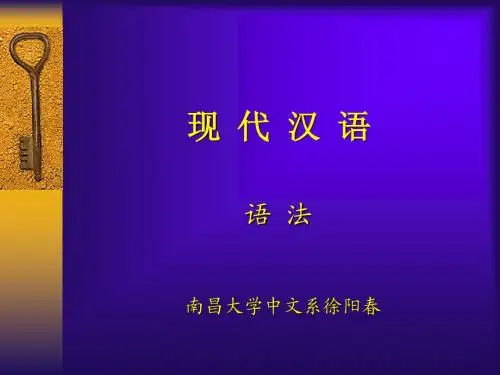
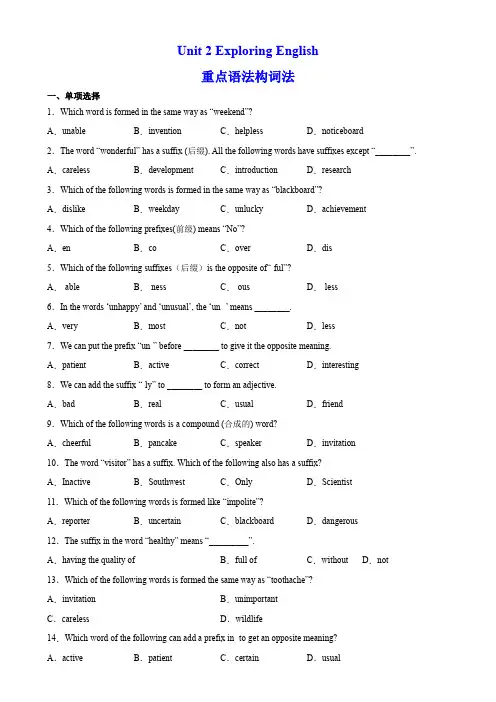
Unit 2 Exploring English重点语法构词法一、单项选择1.Which word is formed in the same way as “weekend”?A.unable B.invention C.helpless D.noticeboard2.The word “wonderful” has a suffix (后缀). All the following words have suffixes except “________”. A.careless B.development C.introduction D.research3.Which of the following words is formed in the same way as “blackboard”?A.dislike B.weekday C.unlucky D.achievement4.Which of the following prefixes(前级) means “No”?A.en- B.co- C.over- D.dis-5.Which of the following suffixes(后缀)is the opposite of“-ful”?A.-able B.-ness C.-ous D.-less6.In the words ‘unhappy’ and ‘unusual’, the ‘un -’ means ________.A.very B.most C.not D.less7.We can put the prefix “un-” before ________ to give it the opposite meaning.A.patient B.active C.correct D.interesting8.We can add the suffix “-ly” to ________ to form an adjective.A.bad B.real C.usual D.friend9.Which of the following words is a compound (合成的) word?A.cheerful B.pancake C.speaker D.invitation10.The word “visitor” has a suffix. Which of the following also has a suffix?A.Inactive B.Southwest C.Only D.Scientist11.Which of the following words is formed like “impolite”?A.reporter B.uncertain C.blackboard D.dangerous12.The suffix in the word “healthy” means “_________”.A.having the quality of B.full of C.without D.not 13.Which of the following words is formed the same way as “toothache”?A.invitation B.unimportantC.careless D.wildlife15.Which one of the following words will be like “really” after adding “-ly”?A.week B.usual C.friend D.love16.Which of the following suffixes(后缀)means “without”?A.-ful B.-less C.-ly D.-tion17.Which of the following words can’t be added with a prefix ‘‘un-’’?A.correct B.necessary C.interesting D.important18.Which of the following words has a different prefix (前缀)to make it have an opposite (相反的)meaning? A.happy B.possible C.kind D.healthy19.We can put the prefix “un—” before the following words to give them the opposite meaning EXCEPT________.A.happy B.cost C.certain D.important20.Which of the following words is created in the same way as “careless” ?A.wonderful B.impatient C.dishonest D.unhappy21.Which of the following prefixes(前缀) means “doing again”?A.en- B.dis- C.un- D.re-22.The following words all have the negative prefixes (否定前缀) EXCEPT ________.A.indoor B.unhappy C.inexpensive D.impossible23.Which of the following words is formed like “unimportant”?A.incorrect B.afternoon C.scientist D.hopeful24.The word “careless” has a suffix. Which of the following word does NOT have a suffix?A.careful B.visitor C.meaning D.certain25.Which of the following is NOT a compound word (合成词)?A.railway B.tour C.housework D.grandson26.Which word can NOT be added the prefix “in-” to give it the opposite meaning?A.complete B.direct C.correct D.proper27.Which of the following words is created in the same way as “blackboard”?A.careless B.impolite C.happiness D.bookshop28.We can put “un-” before the following words except _________.A.correct B.comfortable C.certain D.interesting29.Eiffel Tower is a famous landmark in Paris. Which of the following words is created in the same way as the word “landmark”?30.We can put two words together to create new words. They are called compound words (复合词). Which of the following is not a compound word?A.blackboard B.earphones C.meaningful D.homework31.We cannot add 'un-' to________to give it the opposite meaning.A.possible B.happy C.interesting D.friendly32.Which of the following words has a different prefix to make it have an opposite meaning?A.usual B.polite C.friendly D.certain33.Which of the following suffixes(后缀)means "without"?A.–able B.–ful C.–ous D.–less34.Which of the following words is formed like “impossible”?A.reporter B.blackboard C.dishonest D.harmless35.Which of the following words CAN NOT add the suffix “er” to form a noun?A.speak B.play C.farm D.visit36.Which of the following suffixes is used to form an adjective?A.-less B.-ness C.-tion D.-ion37.The suffix in the word healthy means “__________________”.A.not B.full of C.without D.having the quality of38.Which of the following suffixes is used to form an adjective?A.-less B.-ness C.-tion D.-ment39.He found it unnecessary for us to stay behind. In this sentence, the underlined word “unnecessary” means “________”.A.not patient B.not necessary C.not important D.not tiring40.Which of the following words can NOT be added the prefix "un-" to give it the opposite meaning? A.happy B.healthy C.usual D.polite41.Which of the following words is formed like "handbag"?A.meaningful B.snowman C.protection D.impatient42.Which of the following words is formed like "homework"?A.inventor B.raincoat C.dishonest D.careless43.Which of the following suffixes CANNOT be used to make a noun?A.-less B.-ness C.-tion D.-ment44.In the words homeless and useless, the -less means ______.45.Which of the following words is created in the same way as pancake?A.impolite B.surface C.German D.playground 46.Which of the following suffixes CANNOT be used to make a noun?A.less B.ness C.tion D.ment47.Which word can’t we add “or” to form a noun for a person?A.invent B.visit C.direct D.paint48.Which of the following suffixes(后缀)means "without"?A.—able B.—ful C.—ous D.—less49.Which of the following words has the same word formation as the word “snowstorm”? A.helpless B.incorrect C.government D.blackboard 50.Which of the following words has a different prefix (前缀) to make it have an opposite meaning? A.happy B.correct C.interesting D.certain参考答案:1.D【详解】句意:哪一个单词的构成方式与“weekend”的构成方式相同?考查构词法。
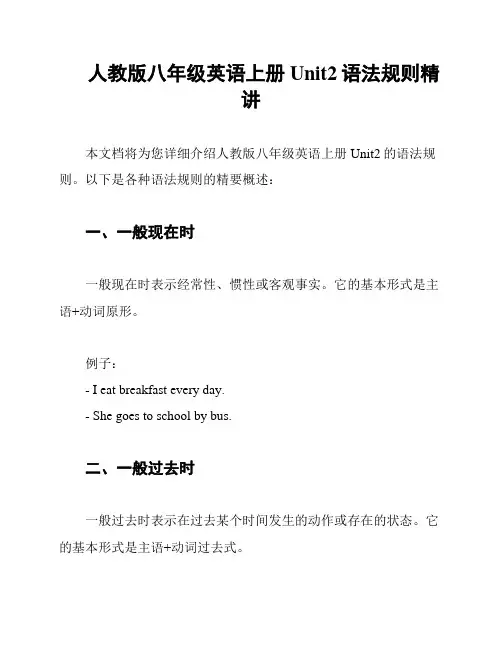
人教版八年级英语上册Unit2语法规则精讲本文档将为您详细介绍人教版八年级英语上册Unit2的语法规则。
以下是各种语法规则的精要概述:一、一般现在时一般现在时表示经常性、惯性或客观事实。
它的基本形式是主语+动词原形。
例子:- I eat breakfast every day.- She goes to school by bus.二、一般过去时一般过去时表示在过去某个时间发生的动作或存在的状态。
它的基本形式是主语+动词过去式。
例子:- He played soccer yesterday.- They visited their grandparents last weekend.三、现在进行时现在进行时表示现在正在发生的动作。
它的基本形式是:be动词(am/is/are)+动词的现在分词。
例子:- They are watching a movie right now.- She is studying for her exam.四、过去进行时过去进行时表示过去某个时间正在进行的动作。
它的基本形式是:was/were + 动词的现在分词。
例子:- We were playing basketball at 5 p.m. yesterday.- He was sleeping when I called him.五、一般将来时一般将来时表示将来某个时间要发生的动作或存在的状态。
它的基本形式是:will/shall + 动词原形。
例子:- We will go shopping tomorrow.- She will attend the meeting next week.以上是人教版八年级英语上册Unit2的语法规则精讲。
希望对您有帮助!。
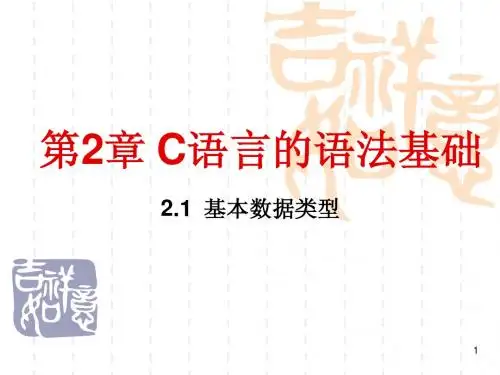
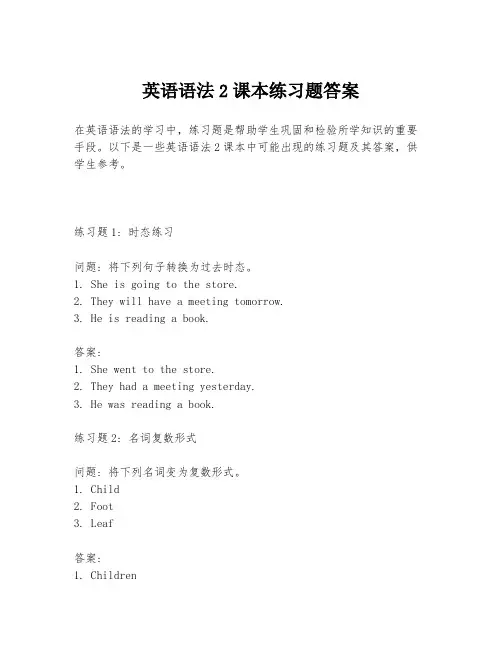
英语语法2课本练习题答案在英语语法的学习中,练习题是帮助学生巩固和检验所学知识的重要手段。
以下是一些英语语法2课本中可能出现的练习题及其答案,供学生参考。
练习题1: 时态练习问题: 将下列句子转换为过去时态。
1. She is going to the store.2. They will have a meeting tomorrow.3. He is reading a book.答案:1. She went to the store.2. They had a meeting yesterday.3. He was reading a book.练习题2: 名词复数形式问题: 将下列名词变为复数形式。
1. Child2. Foot3. Leaf答案:1. Children2. Feet3. Leaves练习题3: 形容词比较级和最高级问题: 将下列形容词转换为比较级和最高级。
1. Big2. Fast3. Happy答案:1. Bigger, Biggest2. Faster, Fastest3. Happier, Happiest练习题4: 被动语态问题: 将下列句子转换为被动语态。
1. They are building a new house.2. Someone will repair the car.3. She is writing a letter.答案:1. A new house is being built (by them).2. The car will be repaired (by someone).3. A letter is being written (by her).练习题5: 冠词使用问题: 选择正确的冠词填空。
1. _______ apple is a fruit.2. _______ man in _______ black is my uncle.3. _______ honest person is always respected.答案:1. An apple is a fruit.2. The man in the black is my uncle.3. An honest person is always respected.练习题6: 介词使用问题: 选择正确的介词填空。
第二章句子类型英语中有四种主要的句子类型:陈述句(declaratives)、疑问句(interrogatives)、祈使句(imperatives)和感叹句(exclamatives)。
(1)陈述句(declaratives),常用主语动词结构。
①They moved into the new house.他们搬到一座新房子里。
②Peter doesn’t like being called by his nickname.彼得不喜欢别人叫他绰号。
(2)疑问句(intererogatives),助动词提到主语前。
①Have you been to Britain?你去过英国吗?②Can I have a few words with you?我能与你说几句话吗?③Who are you waving to?你在向谁挥手?(3)祈使句(imperatives),一般省去主语,除非要强调主语或避免理解错误。
①Watch out!小心!②You shut up!你闭嘴!(4)感叹句(exclamatives),以what或how开头,或跟主语—动词结构。
①What a lovely house you have!你的房子好漂亮啊!②How stupid he was!他多蠢啊!这四种类型的句子有四种功能:(1)陈述句用于陈述事实并提供信息。
(2)疑问句用于询问信息。
(3)祈使句表示命令并要求行动(4)感叹句用于表达感情句法学与语义学必须相符合,我们的社会是一个非常复杂的杜会,语言的社会作用是多样化的。
有的疑问句并不表示疑问,陈述句并不表示肯定,而祈使句并没有发出命令。
例如:①They moved into the new house?他们搬进了一座新房子。
②Why didn't you consult me?你为什么不问问我呢?③Everybody look?大家都看了吗?④Isn't it a lovely garden!好漂亮的花园啊!从意义上讲,①是表示疑问,但在形式上是陈述句;②并不是表示疑问,而表示抱怨或责备;③在句法上是祈使句,但表示疑问更为合适;尽管④的句子结构是疑问句,但很明显是表示感叹的。
六上Unit2 讲义歌曲:《How is the weather?》How is the weather? It's a fine day.How is the weather? It's a cloudy day.How is the weather? It's raining.How is the weather? It's snowing. 词组:What a day! 怎样的一天呀!in the morning在早上go to the park去公园by bike骑自行车a parrot show鹦鹉表演some interesting parrots一些有趣的鹦鹉become windy and cloudy开始刮风fly kites high放风筝高in the sky在天空中some drinks一些饮料on the bread在面包上eat our lunch吃我们的午饭in the afternoon在下午black clouds乌云hungry and wet又饿又湿;well done做得好cheer together一起欢呼look sad 看起来伤心my new kite我的新风筝climb up the hill爬上山fly high飞得高hold onto抓紧fly away飞走了your kite你的风筝near the hill靠近山句型:1. It was sunny.是阳光明媚的一天。
2. I brought some bread and honey.我买了些面包和蜂蜜。
3. What happened?发生了什么?语法:1. on+星期eg:on Saturday在周六 On Sunday morning在星期天早上星期天Sunday 星期一Monday 星期二Tuesday 星期三Wednesday星期四Thursday 星期五Friday 星期六Saturday2. in+月份eg:in July在七月份一月份January(Jan.)二月份February(Feb.)三月份March(Mar. )四月份April(Apr.)五月份May(May )六月份June (Jun.)七月份July(Jul.)八月份August(Aug. )九月份September(Sept. )十月份October(Oct.)十一月份November(Nov.)十二月份December(Dec.)序数词:第1 first 1st第2 second 2nd第3 third 3rd第4 fourth 4th第5 fifth 5th第6 sixth 6th第7 seventh 7th第8 eighth 8th第9 ninth 9th第10 tenth 10th第11 eleventh 11th第12 twelfth 12th第13 thirteenth 13th第14 fourteenth 14th第15 fifteenth 15th第16 sixteenth 16th第17 seventeenth 17th第18 eighteenth18th 第19 nineteenth 19th第20 twentieth 20th第21 twenty-first 21st第22 twenty-second 22nd第23 twenty-third 23rd3. 在具体的日期几月几号前用介词on eg:on the 1st of June在6月1日4.过去式句型的变化. Be动词:There was a king.(肯) Was there a king?(疑)Yes, there was. No, there wasn’t. There wasn’t a king.(否)行为动词:Two men visited the king.(肯) Did two men visit the king?(一般?)Yes, they did. No, they didn’t. Two men didn’t visit the king.(否)Who did the two men visit?(特殊?)一、英汉互译。
七下英语二单元语法
摘要:
一、七年级下册英语第二单元语法概述
1.单元主题
2.语法知识点
二、动词的一般现在时
1.动词的一般现在时构成
2.一般现在时的疑问句与否定句
三、动词的一般过去时
1.动词的一般过去时构成
2.一般过去时的疑问句与否定句
四、情态动词can的用法
1.can的肯定句与否定句
2.can的一般疑问句
五、日常交际用语
1.问候与介绍
2.道别与应答
正文:
七年级下册英语第二单元语法主要涉及动词的一般现在时、一般过去时以及情态动词can的用法,同时学习日常交际用语。
首先,本单元的主题是关于日常交际,通过学习不同场景下的问候、介
绍、道别等用语,提高学生的口语表达能力。
在此基础上,本单元还涉及动词的一般现在时和一般过去时,帮助学生更好地描述动作的发生时间。
在动词时态方面,一般现在时表示现在的习惯、事实或一般情况。
其构成是动词原形,如:I study English every day.一般过去时则表示过去某个特定时间发生的动作,其构成是动词过去式,如:I studied English yesterday.在学习这两个时态时,学生还需掌握疑问句和否定句的构成方法。
此外,本单元还讲解了情态动词can的用法。
can表示能力或允许,用于疑问句时,用can you提问;用于否定句时,用can"t表示不能,如:I can"t swim.对于can的一般疑问句,疑问部分用can you,肯定回答为Yes,I can;否定回答为No,I can"t。
第二章语法非谓语动词——不定式、动名词、分词,没有人称、数、现在和过去时态的区别,不能单独作谓语He is a driver.(他是个司机。
)He to be a driver.She watching TV.(她正在看电视)be+v-ing一、不定式to + v原是不定式最常见的形式,有时不定式是省略“to”的。
Learn English is not easy.不定式在英语中的作用:相当于名词To climb the mountain is very difficult. (作主语)I want to know about the mountain. (宾语)My wish is to conquer the mountain. (表语)相当于形容词I want some water to drink. (修饰名词)相当于副词He stopped to have a rest. (修饰动词)I’m glad to see you. (修饰形容词)总结归纳:除了放在句首作主语这种特殊用法外,其它情况都可以归结为:句中第二个动词前要加“to”。
对于应试来说,不定式部分只需记住一些句型就足够了。
(一)to + v原作主语, + 单数动词To know oneself is difficult. 认识自己很难。
To tell a lie is wrong. 说谎是错误的。
(二)To learn computer is important.It is importantIt is impossible for him to give up smoking. 要他戒烟是不可能的。
It is very kind of you to help me. 你能帮我实在太好了。
It is foolish of them to make such a mistake. 他们犯这样的错误太愚蠢了。
It 是形式主语,真正的主语是to + v.常见的形容词:possible, impossible, important, necessary, essential, convenient, difficult, hard, easy, useless……+for sb常见的形容词:nice, kind, wise, good, polite, bright, clever, bad, wrong, cruel, stupid, foolish, impolite……+of sb.(三)it 作形式宾语,to do 是真正宾语放后面If you study hard, you will find it easy to learn English.如果你用功,你会发现学英语很容易。
I make it a rule to get up early.我把早起定为规则。
We consider it our duty to obey the laws.我们认为遵守法律是我们的职责。
常见的动词:find, think, believe, consider, make, take, regard……(四)疑问词 + 不定式I don’t know what to do.(我不知道该做什么。
)how to do it.(我不知道该怎样做。
)which to buy.He taught me how to speak English well.When to turn the corner is a difficult problem. 何时转变是个难题。
(五)后接to do作宾语的动词有:want, hope, wish, desire, intend, expect, plan, decide, manage, ask, tell, teach, advise, allow, beg, order, pretend,……He intends to try it. 他想试试看。
They allowed me to fish here. 他们允许我在此钓鱼。
不定式的否定形式,在to前加not / neverI told you not to do it. 我告诉过你不要去做。
We decided not to go. 我们决定不去。
省略to的不定式(一)感官动词 see / look at / hear / listen to / feel / notice / smellI saw him swim yesterday. 昨天我看见他游泳了。
I can hear the girl singing in the next room. 我听见有个女孩在隔壁房间唱歌。
I heard my name called. 我听见有人叫我的名字。
被动式:He was seen to swim yesterday.The girl was heard singing in the next room.(二)使役动词及其它特殊动词用法1. let sb do (不带to的动词用法)Let us go home .2.I’ll have him come over. 我会叫他来。
I had my bicycle fixed. 我把自行车送去修理了。
Don’t worry. I’ll have my car waiting downstairs.3.A. hearB. to hearC. hearedD. heard答案:DHe got up early just to make himself catch the first bus.4. help sb (to) do sth Please help me (to) move the table.5. had better + V原(否)had better not + V原You’d better not be late. 你最好不要迟到。
6. would rather + V原……than + V原(宁愿做……而不愿……)I would rather die than do it. 我宁愿死也不愿做这种事。
7. do nothing but + V原, 但是nothing but 之前的动词,若不是do的形式,而是其它动词时,则nothing but 之后的形式,要视该动词而定。
He desires nothing but to live happily. 他只想过快乐的日子。
I think of nothing but learning English well. 我只想把英语学好。
She avoids nothing but seeing him. 她只是避免见到他。
I can do nothing but wait for him. 我只好等他。
(三)不定式的时态和语态主语 + V + to V 表示同时发生,“一般时”表示动作发生的时间与主句的动作同时发生。
主语 + V + to have + p.p. 发生在先,“完成时”表示动作发生的时间比主句的动作早。
注:常用的动词有:seem / appear (似乎)I’m sorry (很抱歉)It is said (据说)I’m glad (很高兴)It is believed (我们相信 be supposed (应该)It is thought (大家认为)不定式的语态to + ——表示主动to be + p.p. ——表示被动To love and to be loved is the greatest happiness on the earth.(爱人和被人爱是世界上最幸福的事。
)(1)下列情形以主动形式表示被动You are to blame. (你应该受责备)The house is to let. (此屋出租)(2)当副词用的不定式,用主动形式Smoking is hard to get rid of. = It is hard to get rid of smoking.He is not easy to get along with. = It is not easy to get along with him.动名词(1) 原形V + ing构成动名词(2) 动名词是具有动词意思的名词I like swimming. (swimming不仅表达"游泳"这个动作,而且是及物动词like的宾语,作名词用)He enjoys fishing.Chatting with them improves my mind.( 和他们聊天增长我的见识。
)(聊天是一件事情,相当于名词)Don't be afraid of speaking English.(不要害怕讲英语) (介词后边只能跟名词或动名词)Do you mind opening the window?(你介意打开窗户吗?)(3)动名词的复合结构I don't like his action.I don't like his smoking here.I'm sure of my brother's passing the examination.He is not satisfied with his son's being late.I don't know his mother's coming here.(我不知道他妈妈来这儿这件事情。
)(4)动名词的否定形式直接在动名词前加notDo you mind not opening the window?Do you mind not smoking here?(5)动名词被动形式由"being + 过去分词"构成完成形式由"having+过去分词"构成(6)以下动词可接动名词也可接不定式。
like ( 喜欢)begin (开始)intend(打算)love (喜爱)start (开始)prefer(较喜欢)hate (憎恨)continue (继续)can't bear/endure (无法忍受)It began raining.It's beginning to rain.(√ )It's beginning raining.(×)I can't bear to see her cry.I can't bear seeing her cry. (我不忍心看她哭。
)(7)下列动词可接动名词或不定式,但意义不同。